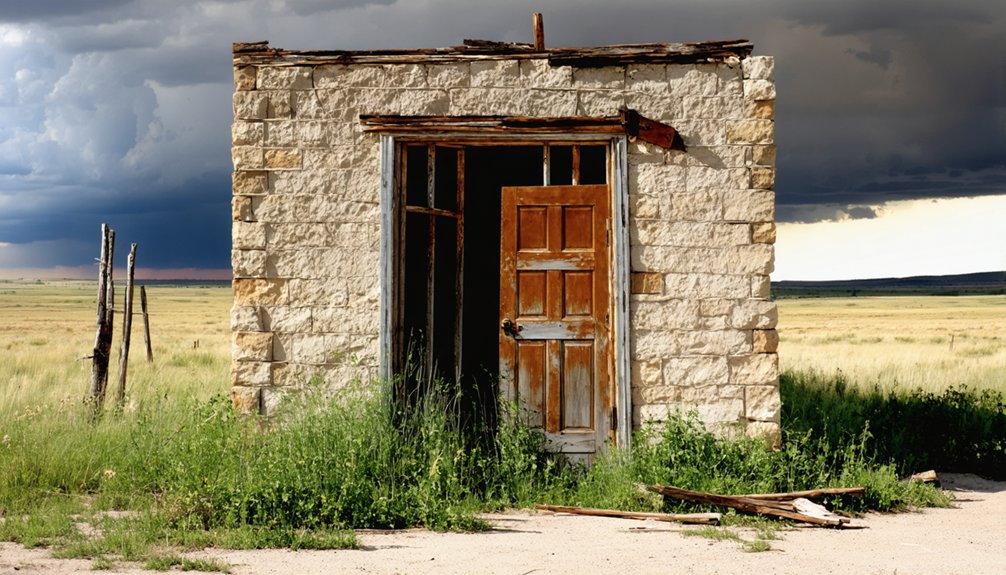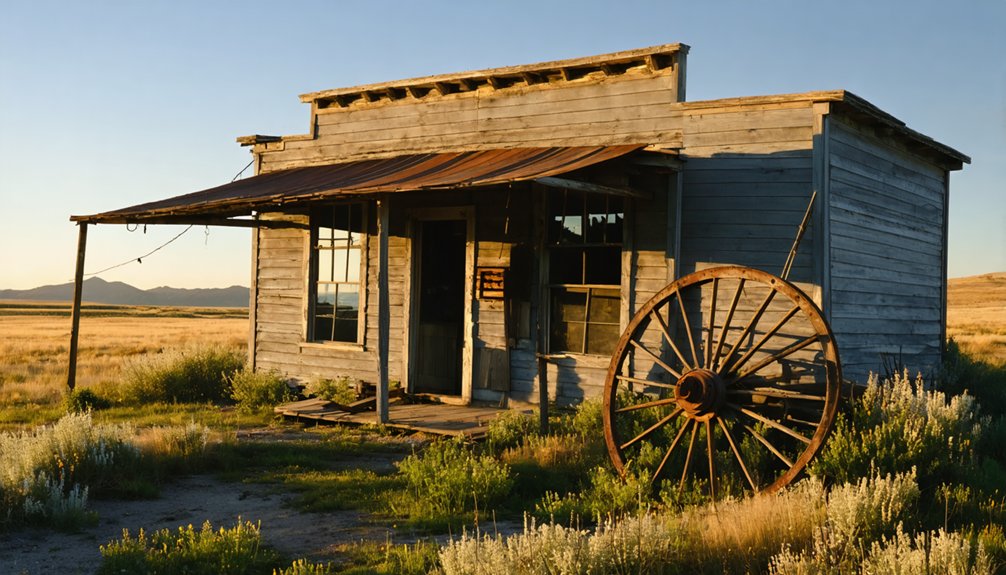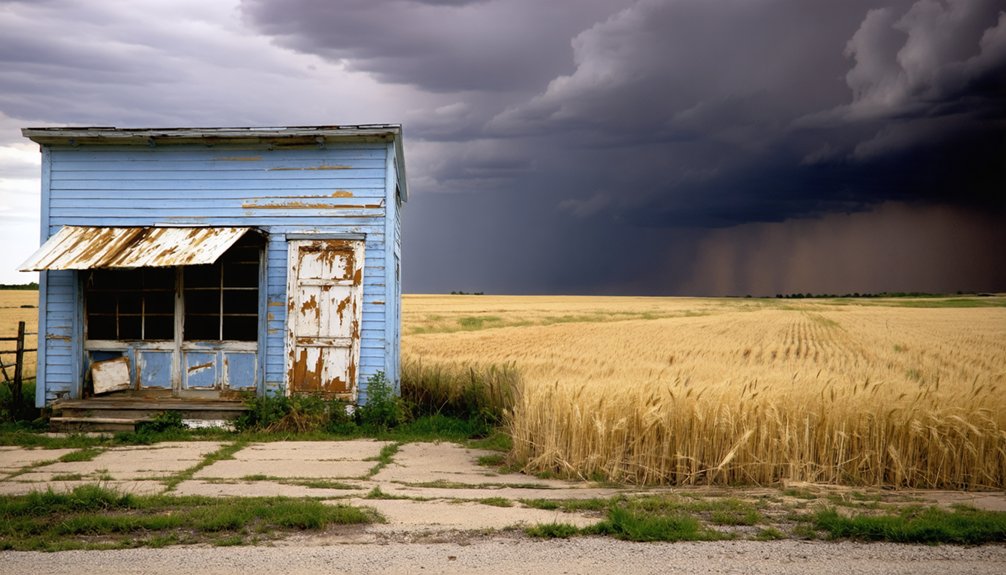You’ll find the ghost town of Minnesela three miles southeast of Belle Fourche, South Dakota, where it once thrived as Butte County’s first seat from 1882 to 1901. Named “red waters” in Lakota, this bustling frontier settlement met its fate when Seth Bullock convinced railroad officials to bypass it for Belle Fourche. Today, only scattered stone foundations and a historical marker on Gaver Road hint at the fascinating story of this vanished prairie town‘s rise and fall.
Key Takeaways
- Minnesela was Butte County’s first seat from 1882-1901 before becoming a ghost town after being bypassed by the railroad.
- The town’s name means “red waters” in Lakota, referencing the nearby Redwater River where the settlement was established.
- Seth Bullock’s influence led railroads to choose Belle Fourche over Minnesela, causing the town’s eventual abandonment.
- Today, only scattered stone foundations remain at the site, with most of the former townsite reclaimed by prairie grassland.
- A historical marker on Gaver Road, three miles southeast of Belle Fourche, commemorates where this once-thriving frontier town stood.
The Origins of Minnesela’s Name
The name “Minnesela” represents a fascinating intersection of Lakota culture and South Dakota’s early settlement history.
You’ll find its roots deeply embedded in Lakota heritage, as the name translates to “red waters” – a direct reference to the Redwater River that flows through the area.
When settlers established the town in 1882, they chose to preserve this meaningful indigenous name that perfectly captured the distinctive geographical features of the region.
At 3,173 feet above sea level, Minnesela‘s location, about three miles southeast of present-day Belle Fourche, gave settlers a prime position along the river’s crimson-tinted waters.
The community’s prosperity was short-lived when the new county seat shifted to Belle Fourche after the railroad depot was established there.
The name stands as a tribute to how natural landmarks and Native American languages shaped the identity of early South Dakota communities, even as European influences began to take hold. Like many ghost towns in disrepair, Minnesela’s remaining structures tell the story of its eventual decline and abandonment.
A Flourishing Frontier Settlement
Along the banks of the red waters that gave Minnesela its name, a vibrant frontier settlement took root in 1882. The frontier economy thrived as settlers and ranchers transformed this outpost into a bustling hub of commerce and community resilience. This prosperity would end when Belle Fourche gained control of the county seat in 1894. The area’s early development was shaped by French fur traders who had named the nearby rivers in the 1780s.
You’d have found a diverse mix of European immigrants, particularly Norwegians, working alongside cowboys and farmers to build their American dream.
The settlement’s key features included:
From trading posts to churches, Minnesela’s vital institutions formed the backbone of this ambitious frontier settlement.
- A robust livestock and agricultural trade center serving the Tri-State region
- Multiple saloons and supply stores catering to hardworking ranchers
- Essential community institutions including schools and churches
As county seat of Butte County, Minnesela’s influence extended beyond its borders, creating a stronghold of governance and commerce that defined this remarkable chapter in Dakota Territory’s history.
The Railroad Decision That Changed Everything
During the Great Dakota Boom of 1878-1887, railroads wielded extraordinary power to determine which frontier settlements would prosper and which would fade into obscurity.
For Minnesela, the stakes couldn’t have been higher as railroad expansion reshaped settlement patterns across South Dakota. The post has received 18 likes since being shared on February 4, 2024.
You’d have seen the town’s leaders desperately competing to secure a rail line, offering financial incentives and free right-of-way. They knew that without the railroad’s faster, more reliable transportation, their town’s future hung in the balance.
When railroad officials ultimately chose to route the line through Belle Fourche instead, they sealed Minnesela’s fate. Local lawman Seth Bullock played a crucial role in influencing this decision.
While Belle Fourche rapidly grew with new businesses, warehouses, and residents flocking to the rail-connected town, Minnesela began its slow descent into abandonment, becoming yet another casualty of the railroad’s transformative power.
Seth Bullock’s Role in Minnesela’s Fate
You’ll find Seth Bullock’s calculated maneuvering with the railroad was the key to Minnesela’s eventual ghost town status, as he strategically purchased land along the Belle Fourche River for 14 years before making his move.
Through shrewd negotiations, he offered the railroad free right-of-way on his property and proposed building a terminal for just $1, effectively luring them away from Minnesela.
His power play worked perfectly – by 1890, the railroad’s arrival at Bullock’s chosen location sealed Minnesela’s fate while simultaneously establishing Belle Fourche as what would become the world’s largest livestock shipping point. Within just five years, the booming town was shipping up to 2,500 carloads of cattle during peak seasons. As a United States Marshal, Bullock’s influence and authority helped him navigate both business and political landscapes to achieve his goals.
Railroad Dealings and Deception
A web of railroad politics and strategic maneuvering sealed Minnesela’s fate in the late 1880s, with Seth Bullock emerging as a key player in the town’s ultimate demise.
The railroad negotiations between Minnesela’s Board of Trade and the FE&MV Railroad created an economic rivalry that would reshape the region’s future. Like many towns competing for railroads, Minnesela’s desperate attempts to attract the line proved futile against powerful business interests.
- Minnesela’s leaders believed they’d secured the railroad’s commitment to build through their town.
- The FE&MV Railroad secretly planned to establish their station at Belle Fourche instead.
- Seth Bullock’s business interests aligned with Belle Fourche, influencing the railroad’s decision.
You can still see the consequences of these backroom deals today.
While Minnesela’s boosters organized their Board of Trade in June 1889, they were already too late – the die had been cast in Belle Fourche’s favor through carefully orchestrated deception.
Power Behind Town’s Downfall
When Seth Bullock set his sights on developing Belle Fourche in the late 1880s, he orchestrated one of the most calculated town-building campaigns in Dakota Territory history.
Through his roles as sheriff and businessman, he wielded considerable influence to fuel an economic rivalry between Belle Fourche and Minnesela. You’ll find his strategic moves were ruthlessly effective – offering free lots to Minnesela’s residents and businesses while simultaneously securing the railroad’s commitment to bypass the established town completely.
The civic competition reached its climax in 1894 when Belle Fourche won the county seat election, but Bullock’s earlier machinations had already sealed Minnesela’s fate. The town that replaced Minnesela would soon become the largest livestock railhead in the United States, cementing Bullock’s vision for the region’s economic future.
What Remains of the Ghost Town Today

As you walk the abandoned site of Minnesela today, you’ll spot scattered stone foundations and footings that hint at the town’s former layout.
The open prairie has reclaimed most of the original townsite, transforming bustling streets and buildings into quiet grassland near the Redwater River.
You can still find a historical marker that commemorates this once-promising settlement, which served as Butte County’s first seat before Belle Fourche took its place.
Visible Building Foundations
Today’s visitors to Minnesela’s former site will find little evidence of the once-thriving frontier town.
The land where this historic settlement once stood has largely reverted to open pasture, with no significant building remnants or archaeological findings visible to mark its existence.
The location’s transformation from a bustling county seat to empty fields reflects the harsh realities of frontier life.
You’ll find:
- Empty fields and pastureland where buildings once stood
- The meandering Redwater River that once sustained the community
- The same elevation and geographical features that attracted the original settlers
The site’s barren state serves as a stark reminder of how quickly a town can vanish when economic forces shift.
The absence of preserved foundations or structures makes it challenging to envision the community that thrived here until 1901.
Memorable Historical Marker Site
A solitary historical marker stands as the primary evidence to Minnesela’s existence, located on Gaver Road about one mile east of Helmer Road near Belle Fourche.
You’ll find this representation of the town’s historical significance about three miles southeast of Belle Fourche’s city center, near the Redwater River that inspired the settlement’s name.
The marker reveals Minnesela’s cultural heritage, explaining how the name comes from Lakota words meaning “red waters.”
While you won’t see any remaining buildings at the site today, this marker commemorates the town’s brief but important role as Butte County’s first county seat from 1882 to 1901.
The town’s fate was sealed when railroad developers chose to bypass it, leading to its eventual abandonment in favor of Belle Fourche.
Open Prairie Landscape Now
The once-bustling town of Minnesela has transformed into quiet prairie land, with little evidence remaining of its former existence.
Today, you’ll find an open grassland where natural reclamation has erased nearly all traces of the former county seat. The site exemplifies how quickly a town can fade into memory, with no standing structures remaining to mark its historical significance.
If you visit the site today, you’ll discover:
- Empty fields and pasture where buildings once stood
- Minimal visible foundations or footings beneath prairie vegetation
- A serene landscape that’s reverted to its natural state
The stark contrast between Minnesela’s abandoned grounds and the thriving nearby Belle Fourche serves as a poignant reminder of how railroad politics and economic shifts can determine a town’s fate.
Historical Legacy and Cultural Impact

Marking a pivotal chapter in South Dakota’s frontier history, Minnesela’s rise and fall dramatically shaped the region’s cultural identity from 1882 to 1901.
You’ll find its cultural significance deeply rooted in the Lakota language, with its name meaning “red water” – a reflection of the area’s indigenous heritage.
The historical narrative of Minnesela reflects the broader story of Western expansion, where a town’s destiny hinged on railroad politics and personal influence.
Seth Bullock’s strategic maneuvering to route the railroad through Belle Fourche sealed Minnesela’s fate, demonstrating how individual actions could reshape entire communities.
Today, you can trace this legacy through documentaries like “Vanished South Dakota” and the remaining structures that stand as silent witnesses to a once-thriving frontier settlement.
Frequently Asked Questions
What Was the Peak Population of Minnesela During Its Most Prosperous Years?
You’ll find that during peak prosperity, Minnesela reached about 100 residents around 1882-1890, but the railroad’s bypass triggered a swift population decline until its complete abandonment by 1901.
Were There Any Major Crimes or Notable Lawlessness in Minnesela?
In a town of just 100 residents, you won’t find documented major crimes or notable lawlessness. While frontier towns often faced disorder, Minnesela’s law enforcement benefited from U.S. Marshal Seth Bullock’s regional influence.
What Businesses and Services Existed in Minnesela Besides the Hotel?
You’d have found typical frontier town services including a grocery store and blacksmith shop, though exact records are limited. Like other small settlements, basic necessities were available while they operated.
Did Any Famous Pioneers or Settlers Make Minnesela Their Permanent Home?
You won’t find any famous settlers or pioneer families who called Minnesela home permanently. Even Seth Bullock, who influenced the town’s fate, focused his attention on developing Belle Fourche instead.
What Happened to the Residents After Minnesela Became a Ghost Town?
You’ll find that most residents moved to Belle Fourche, drawn by railroad jobs and business opportunities. Their relocation stories reflect the community impact as families rebuilt their lives in neighboring towns.
References
- https://kids.kiddle.co/Minnesela
- https://hpr1.com/index.php/feature/culture/festivals-of-history-in-south-dakota
- https://evendo.com/locations/south-dakota/northwest-south-dakota/landmark/historical-minnesela-town-site-marker
- https://www.youtube.com/watch?v=Fzt03lXwTNs
- https://en.wikipedia.org/wiki/List_of_ghost_towns_in_South_Dakota
- https://history.sd.gov/preservation/docs/RuralButteMeadeCo.pdf
- https://www.instagram.com/reel/C27S_TRsDr9/
- https://myxoadventures.com/a-history-of-belle-fourche-south-dakota/
- https://www.thetristatemuseum.com/history-of-belle-fourche/
- https://www.youtube.com/watch?v=Glucs_Rq8Xs



